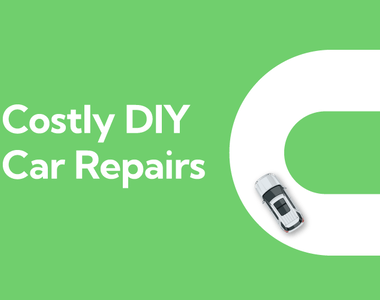Learn the MOT requirements for Category S cars, common issues to prepare for, and the implications of buying or selling a Cat S vehicle.
If you're buying or selling a written-off car, its salvage category status affects several factors, including when it needs its first new MOT. In this article, we'll break down what you need to know about a Category S car and its MOT requirements.
Whether you're selling a written-off car or buying one yourself, its salvage category status (A, B, S, N, U, X) significantly affects the price, potential issues with the vehicle, and implications of ownership.
Category S is one of four main insurance write-off categories a salvage car can fall under, and it means the vehicle has sustained structural damage.
To answer the question: Yes, a Category S car, which has sustained structural damage, does require a new MOT test after it has been repaired and before it can be driven again. This is to ensure that the vehicle is roadworthy and safe to operate on public roads following the structural repairs.
This is different from a Category N vehicle (which refers to non-structural damage). Cat N vehicles don't necessarily require a new MOT test before it is driven again, provided their existing MOT certificate is still valid.

Why does a Cat S car require a new MOT?
While there isn't a specific legal requirement (so long as its current MOT certificate hasn't expired), Category S write-offs are classified as such because they pose certain risks to road safety — beyond the value of the vehicle itself, might we add.
For example, structural damage to a car can affect its handling and stability, making it potentially dangerous to drive if not repaired correctly.
So, there are a few reasons your Cat S car needs a new MOT, even if its current MOT certificate is technically still valid:
Structural integrity
Structural damage affects the core framework of the vehicle, including components like the chassis and crumple zones. Repairing these elements is crucial to restoring the vehicle's safety. A new MOT ensures that these repairs have been carried out correctly and that the vehicle meets all necessary safety standards before being driven on public roads.
Legal technicalities
Once a Cat S car is repaired, it must be re-registered with the DVLA. This typically includes passing an MOT. This step verifies that the vehicle has been properly repaired and is safe to drive. The re-registration process ensures transparency and safety for both the current owner and any potential future buyers.
Safety assurance
An MOT test provides an independent check of the vehicle's safety features, including brakes, lights, steering, and suspension. This is especially important for a car that has undergone significant repairs, as it helps to identify any issues that might not have been apparent during the repair process.
Insurance requirements
Practically every car insurance company will refuse to cover a salvage car before it has passed a new MOT test. Even if your current insurer is aware of the repairs, they will likely require a new MOT certificate before providing coverage for the vehicle again.
How soon after buying a Cat S car should I get a new MOT?
After purchasing a Category S (Cat S) car, we recommend getting an MOT test done immediately, or as soon as possible.
Otherwise, you won't be able to purchase a new insurance policy on it. And proof of insurance cover is a prerequisite to paying road tax and registering it with the DVLA.
Besides the MOT, consider getting an independent inspection from a professional service like the AA. This will provide an additional layer of assurance that the car is safe and that all repairs have been done to a high standard. It will also verify the engine, clutch, and gearbox on the salvage car are in working order — three components not tested during the MOT.
Common issues found during a Cat S Car MOT
Although it varies by make, model, and year, DVSA data finds that across the board, roughly 1 in 3 cars fail its MOT. When it comes to buying a Cat S car, common failure points normally relate to the vehicle's outer structure and internal components that are directly affected by the damage.
These include:
- Remaining structural problems. Signs of poor structural repairs, like misaligned panels or uneven surfaces, will be flagged during the MOT. The repairs must restore the structural integrity to ensure safety in case of another accident.
- Suspension and steering. Given the nature of structural damage, the suspension and steering components are closely inspected for any issues such as wear, damage, or improper alignment.
- Brakes. An MOT will check for worn brake pads, discs, and any other components that might affect braking performance. Issues like uneven braking or noises during braking lead to a failure.
- Lights and indicators. All lights, including headlights, brake lights, indicators, and number plate lights, must be fully operational.
- Tyres. Worn (below 1.6mm tread depth) or damaged tyres will fail the MOT, regardless of the car's make and model.
- Exhaust and emissions. The exhaust system must be intact without leaks, and the vehicle must meet emission standards.
- Electrical components. Damage to internal wiring or electrical systems can cause issues with various components, including the horn, windscreen wipers, and sensors.
When repairing a salvage car, people tend to focus on the aesthetic aspect. It's common to overlook aspects that weren't directly related to the damage.
In reality, every Cat S car needs a complete examination and overhaul before it is deemed safe to drive. If you don't invest in a thorough inspection before your MOT, you'll probably wind up with a fail for one of these reasons and an unexpected bill to fix the issues.
What is required for a Cat S car MOT?
For a Category S car to pass its MOT, it will go through the main inspection for all Class 4 vehicles, including a range of checks on the vehicle's structure and safety features.
While there are more than 20 different sections inspected during an MOT (read up on all of them in our MOT checklist), these are the main areas you'll have to worry about:
- Body and structure
- Suspension and steering
- Brakes
- Tyres and wheels
- Exhaust system and emissions
- Fuel system
- Electrical components
- Windscreen, wipers, and washers
- Lights, horn, and mirrors
- Doors and safety features
After the repairs, the Cat S car must be re-registered with the DVLA. Ensure you have all the necessary documentation, including a new V5C logbook that reflects the vehicle’s Cat S status.
Are there specific tests for Cat S cars during their MOT?
The MOT test is only a basic safety check and does not provide a comprehensive examination of the vehicle's condition. As such, there are no specific tests for Cat S cars during their MOT.
This means the MOT test itself is not a guaranteed safeguard against shoddy repair work. While it will certainly catch some issues, it won't tell you if the car has been repaired correctly or whether it's in overall good condition.
If you're buying or selling a salvage car, we strongly recommend having it independently tested by a reputable third party before purchasing or listing it to ensure no underlying issues.
What happens when a Cat S car fails its MOT?
When your car fails its MOT, you'll receive a VT30 ‘Refusal of MOT Certificate’ that details the reasons for the failure. The issues can be categorized as dangerous, major, or minor defects.
- Dangerous defects render the vehicle unroadworthy. You cannot legally drive it anywhere, even directly to a repair garage to make the fixes.
- Major defects also need to be fixed, but you may drive the car if your current MOT certificate is still valid or if you're going straight to a pre-booked repair garage.
- Minor defects do not cause an MOT failure but should be addressed within the next year.
Depending on the defects, you can choose to have the vehicle repaired at the test centre or another garage. If you leave the car at the test centre for repairs, it can be retested for free within 10 working days.
How often should a Cat S car go in for an MOT?
Your MOT certificate expires one year after the test date. However, you can get your MOT done up to a month (minus one day) before the expiration and still keep the same renewal date. If you take it in before this, you'll get a new MOT certificate with an expiration date 12 months from the test's original date.
With this in mind, we recommend getting your Cat S car tested once every year, at least one month before its expiry. It's illegal to drive on public roads without a valid MOT certificate, so planning in advance is a must.
Although an MOT is an annual check, you shouldn't forget your Cat S car's history of significant structural damage. Take it in for an interim inspection and service every six months to a year (depending on its age/mileage and your usage levels) to ensure it remains safe and roadworthy.
What impact does Cat S status have on car value?
Category S cars almost always have a lower market value compared to similar cars without such a designation. This is mainly due to the stigma attached to salvage vehicles and potential issues that may arise from previous significant structural damage.
Accident history in general decreases a car's value, as it may affect its safety and reliability. A Category S insurance write-off is essentially saying, "The structural damage was so severe that it would have cost us more to repair than it would to just replace the car."
To your typical buyer, that isn't a good sign.
Not to mention, the typical Cat S car buyer is doing so because they're looking for a cheap deal. You're practically guaranteed to have buyers haggle for an even better price because of its salvage history.
See what your car is worth using our free car valuation tool.
Can I sell a Cat S car without a new MOT?
While it's perfectly legal to sell a car without an MOT (write-off history or otherwise), there are several reasons why you shouldn't do it.
First and foremost, savvy buyers will most likely ask why the car doesn't have a valid MOT and what repairs it needs. Without an MOT certificate or regular servicing records, you'll struggle to convince them the vehicle is safe.
The buyer also won't be able to tax the car, insure it, or drive it on public roads without a valid MOT. This means they will need to arrange for the car to be transported post-purchase. This generally reduces the car's already-diminished resale value as it adds tremendous inconvenience for the buyer.
Note: You are legally obligated to inform the buyer that the car is a Category S vehicle. Failure to do so can result in legal action from the buyer.
Where can I get an MOT done for my Cat S car?
You can get your MOT test done at any one of the UK's 23,000+ MOT test centres. The maximum cost for an MOT is set by the government at £54.85, but the actual price can vary from centre to centre (and by make and model).
You may also want to consider any additional costs for repairs or retesting if your car fails its first MOT. Since you may not be able to leave the garage for repairs, you want to choose a test centre that has a reputation for fair-priced, high-quality repair work.
How do I know if my car is a Cat S vehicle?
If you owned the car before it was written off, you'll know it's Cat S because your insurer would've told you.
If you're buying a Cat S car, there are a few ways you can find this out on your own:
- Check the V5C logbook (if it's already been updated)
- Use the DVLA’s online vehicle enquiry service (it's free)
- Ask the seller (they're legally obligated to tell you)
The bottom line
Remember that the MOT test (while required) is just a basic test of vehicle roadworthiness and environmental standards. It does not provide a comprehensive examination of the car's condition, including its assessment of prior structural damage.
If you plan to buy or sell a Cat S car, the best way to maximize its value and ensure you get the best deal is to have it professionally inspected by a third party. This will give you a more accurate idea of its condition and any potential issues that may affect its value or safety.
Check the MOT status and history of any vehicle using our free MOT checker.












